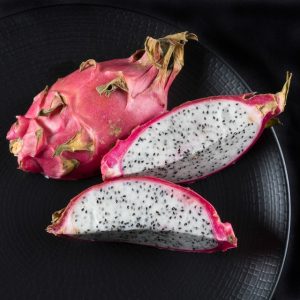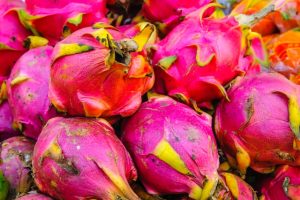Dragon fruit, also known as pitaya, is a tropical fruit that has become increasingly popular in recent years due to its unique appearance and delicious taste.
Many people wonder if it is possible to grow dragon fruit in Arkansas, given the state’s climate and growing conditions.
The answer is yes, it is possible to grow dragon fruit in Arkansas, but it requires careful attention to the specific needs of the plant.
Understanding dragon fruit is the first step to successfully growing it in Arkansas. Dragon fruit is a climbing cactus that requires support, such as a trellis or climbing pole, to grow properly.
It also requires well-draining soil that is sandy and loamy, and it needs to be watered regularly but not overwatered.
In addition, it is important to know the ideal growing conditions for dragon fruit, including temperature, humidity, and sunlight requirements.
Growing dragon fruit in Arkansas requires attention to the specific needs of the plant, including soil and watering requirements, planting and care, propagation methods, and pest and disease management.
It is also important to know when to harvest the fruit and how to use it in cooking and other applications.
With the right knowledge and care, it is possible to successfully grow dragon fruit in Arkansas and enjoy its unique flavor and nutritional benefits.
Key Takeaways
- Dragon fruit can be successfully grown in Arkansas with careful attention to its specific needs.
- Understanding the ideal growing conditions, soil and watering requirements, and pest and disease management is key to growing healthy dragon fruit plants.
- With the right knowledge and care, dragon fruit can be a delicious and nutritious addition to any garden in Arkansas.
Understanding Dragon Fruit
Dragon fruit, also known as pitaya, is a tropical fruit that is native to South and Central America.
It is a type of climbing cactus that produces large, showy flowers that bloom only at night. The fruit is typically oblong or oval-shaped, with a scaly, bright pink or red outer skin and a white or pink flesh that is studded with small, black seeds.
Dragon fruit is a unique fruit that has a refreshing taste and a mild sweetness. It is low in calories and high in fiber, making it a great choice for anyone who is looking to maintain a healthy diet.
The fruit is also rich in antioxidants, vitamins, and minerals, including vitamin C, iron, and calcium.
There are several different types of dragon fruit, including the red dragon fruit, which has a bright pink or red outer skin and a white or pink flesh, and the yellow skin dragon fruit, which has a yellow outer skin and a white flesh. Both types of dragon fruit are equally delicious and nutritious.
Overall, dragon fruit is a delicious and healthy fruit that is perfect for anyone who is looking for a refreshing and nutritious snack.
Whether you are looking for a new fruit to add to your diet or you are a fan of exotic fruits, dragon fruit is definitely worth trying.
Growing Conditions in Arkansas
Dragon fruit is a tropical fruit that is native to Central and South America. It is known for its unique appearance and sweet, juicy taste.
While it may seem like a fruit that can only be grown in tropical regions, it is possible to grow dragon fruit in Arkansas with the right growing conditions.
Climate
Arkansas has a humid subtropical climate, with hot summers and mild winters. The state is divided into two main regions: the Ozark Plateau region in the north, and the Gulf Coastal Plain region in the south.
The climate in these regions can vary, but generally, Arkansas has a warm and humid climate that is suitable for growing dragon fruit.
Temperature
Dragon fruit plants require warm temperatures to grow and thrive. They prefer temperatures between 65 and 77 degrees Fahrenheit and can tolerate temperatures down to 40 degrees Fahrenheit.
However, the extremely hot sun can burn the stems of young plants, and a deep frost can kill them.
Full Sun
Dragon fruit plants require full sun to grow and produce fruit. They need at least six hours of direct sunlight each day to thrive.

If you are growing dragon fruit in Arkansas, it is important to choose a location that receives plenty of sunlight throughout the day.
Heat
In addition to full sun, dragon fruit plants also require heat to grow and produce fruit. They need warm temperatures to encourage flowering and fruiting.
If you are growing dragon fruit in Arkansas, it is important to choose a location that is protected from cold winds and frost.
Zones
Arkansas is located in USDA Hardiness Zones 6-8, which means that it has a moderate climate that is suitable for growing a wide variety of plants.
Dragon fruit plants can be grown in these zones, but may require some protection during the winter months.
Climates
While dragon fruit plants can be grown in a variety of climates, they prefer warm and humid conditions.
If you are growing dragon fruit in Arkansas, it is important to keep the soil moist and provide plenty of water during the hot summer months.
Overall, dragon fruit can be grown in Arkansas with the right growing conditions. By choosing a location with full sun, warm temperatures, and protection from cold winds and frost, you can successfully grow this tropical fruit in your backyard.
Soil and Watering Requirements
Dragon fruit plants require specific soil and watering conditions to thrive. The soil should be well-drained, and it is best to plant the dragon fruit in soil that has good drainage holes.
Sandy soil is ideal for dragon fruit plants as it provides plenty of air space for the roots. Any soil that has a coarse texture to provide your dragon fruit with plenty of air space will do just fine. It is essential to ensure that the soil is clean and free of any weeds, roots, or debris.
Dragon fruit plants prefer soil that is slightly acidic, with a pH range of 6.0 to 7.0. If the soil is too alkaline, the plant may not grow well and may develop yellow leaves.
If the soil is too acidic, the plant may not absorb nutrients properly. It is best to test the soil’s pH level before planting the dragon fruit to ensure that it is within the ideal range.
Dragon fruit plants need regular watering, especially during the growing season. Water the plants when the soil is dry to the touch, but avoid overwatering as it can lead to root rot. It is best to water the plants deeply, allowing the water to soak into the soil.
The frequency of watering will depend on the weather conditions and the soil type. In general, dragon fruit plants require 800 to even 2,500 mm of water yearly (either from irrigation or rainfalls).
If we get much rain, we may not need water. This is during the rainy season. Moreover, even in the summer, we can still get some rain weekly. In that case, once a week of watering is enough.
Fertilizing the dragon fruit plants is also essential to ensure healthy growth. It is best to fertilize the plants monthly with a balanced fertilizer.
Compost can also be used as a natural fertilizer. Avoid using fertilizers that are high in nitrogen as they can promote leaf growth at the expense of fruit production.
Ideal Time For Planting and Care
Dragon fruit can be grown successfully in Arkansas with proper planting and care. When planting dragon fruit, it is important to choose a variety that is suitable for the climate in Arkansas. The ideal time to plant dragon fruit in Arkansas is in the spring after the last frost.
Dragon fruit can be planted in pots or in the ground. If planting in pots, choose a container that is at least 20 inches in diameter and 10 inches deep. Use a well-draining potting soil that is rich in organic matter.
Dragon fruit plants require good drainage, so it is important to add perlite or sand to the potting soil to improve drainage.
When planting in the ground, it is important to choose a location that receives full sun. Dragon fruit plants require at least 6 hours of direct sunlight per day to grow and produce fruit.
If planting in an area with hot summers, it is recommended to plant the dragon fruit plant in a semi-shaded area to protect it from the intense heat.
Dragon fruit plants require regular fertilizing to grow and produce fruit. Fertilize the plant every 2-3 months with a balanced fertilizer that is high in phosphorus.
If growing the plant in a pot, it is important to fertilize more frequently as the nutrients in the soil will be depleted faster.
Dragon fruit plants are low maintenance and require minimal care. However, it is important to provide support for the plant as it grows.
Use a trellis or stake to support the plant and prevent it from falling over. Water the plant regularly, but do not overwater as this can lead to root rot.
In conclusion, growing dragon fruit in Arkansas is possible with proper planting and care.
Choose a suitable variety, plant in a well-draining potting soil, provide regular fertilizing, and support the plant as it grows. With these simple steps, you can enjoy fresh dragon fruit right from your backyard.
Propagation Methods
Dragon fruit can be propagated through seeds or cuttings. However, the most common method is through cuttings as it is easier and faster.
Cuttings
To propagate through cuttings, obtain a 6 to 15-inch stem segment and make a slanted cut at the base of the stem.
Treat the cut with a fungicide and leave it to dry for seven to eight days in a dry, shaded area.

After this period, plant the cutting into a pot or directly into the ground. In about half a month, it roots into the soil. If started in a pot first, it can be transplanted into the soil after half a month. Dragon fruit takes around fourteen months to fruit in tropical climates from cuttings.
Seeds
Propagation through seeds is also possible, but it takes longer and is less reliable than cuttings. To propagate through seeds, soak the seeds in water for a day or two before planting them in a well-draining soil mix.
Keep the soil moist and warm, and the seeds should germinate in two to four weeks. However, it may take up to two years for the plant to start producing fruit.
Pollination
Dragon fruit is self-fruitful, meaning it can produce fruit without cross-pollination. However, cross-pollination can increase fruit production.
Moths and bats are the natural pollinators of dragon fruit, but they are not always present in all areas. In such cases, hand pollination can be done by using a small brush to transfer pollen from the stamen to the stigma.
In conclusion, dragon fruit can be propagated through cuttings or seeds. Cuttings are the most common method and can produce fruit in as little as fourteen months. Dragon fruit is self-fruitful but can benefit from cross-pollination.
Pests and Diseases
Like any other fruit, dragon fruit is susceptible to pests and diseases. In Arkansas, growers may encounter several pests and diseases that can harm their dragon fruit plants. Here are some of the common pests and diseases that dragon fruit growers in Arkansas should be aware of:
Pests
Aphids
Aphids are small, pear-shaped insects that suck the sap from the leaves of dragon fruit plants.
They can cause the leaves to curl and turn yellow, and can also spread viruses from plant to plant.
To control aphids, growers can introduce natural predators like ladybugs or lacewings, or spray the plants with water.
Mealybugs
Mealybugs are small, white, cottony insects that feed on the sap of dragon fruit plants. They can cause yellowing of leaves, stunted growth, and wilting. To control mealybugs, growers can use insecticidal soap.
Diseases
Root Rot
Root rot is a fungal disease that affects the roots of dragon fruit plants. It can cause the roots to turn brown and mushy, and the plant to wilt and die. Root rot is caused by overwatering and poor drainage.
To prevent root rot, growers should avoid overwatering their plants and ensure that the soil has good drainage.
Fungal Infections
Fungal infections can affect the stems, leaves, and fruit of dragon fruit plants. Anthracnose is a fungal disease that can infect dragon fruit. It causes halo-like concentric lesions on stems and fruit.
Bipoaris cactivora is a pathogen that causes black/brown spotting on pitaya blossoms and fruit. When the infection is severe, it manifests in branch/stem rot as well.
To control fungal infections, growers can use fungicides and practice good sanitation by removing infected plant parts.
In summary, dragon fruit growers in Arkansas should be aware of the common pests and diseases that can affect their plants.
By practicing good sanitation, using natural predators, and applying appropriate treatments, growers can prevent and control pests and diseases and ensure the health and productivity of their dragon fruit plants.
Harvesting and Usage
Dragon fruit is ready to harvest when the fruit is bright red and slightly soft to the touch. The fruit is harvested by twisting it gently until it comes off the stem. The fruit should be handled carefully as it bruises easily.
Once harvested, dragon fruit can be used in a variety of recipes. The fruit can be eaten fresh or used in smoothies, salads, or as a topping for yogurt or ice cream. The fruit can also be used to make jams, jellies, and syrups.
Dragon fruit can be stored in the refrigerator for up to a week. To store the fruit, it should be placed in a plastic bag or container and kept in the refrigerator.
In addition to the fruit, the dragon fruit plant can also be used. The flowers of the plant can be used to make tea, and the leaves can be used as a vegetable or in salads.
Overall, dragon fruit is a versatile and nutritious fruit that can be enjoyed in a variety of ways. With proper harvesting and storage techniques, the fruit can be enjoyed for up to a week after it is harvested.
Growing Dragon Fruit in Containers
Dragon fruit can be grown in containers, making it an excellent option for people who live in Arkansas and want to grow this exotic fruit. When growing dragon fruit in containers, there are a few things to keep in mind.
First, it is essential to choose the right container. Dragon fruit plants have shallow roots, so a container that is at least 15 gallons in size is ideal. The container should also have drainage holes to prevent water from accumulating at the bottom and causing root rot.
Second, the potting soil used should be well-draining and rich in nutrients. A mixture of sand, perlite, and peat moss is an excellent choice for growing dragon fruit in containers. It is also essential to fertilize the plant regularly to ensure it gets the nutrients it needs to grow and produce fruit.
Third, dragon fruit plants need plenty of sunlight to grow and thrive. When growing dragon fruit in containers, it is best to place the container in a location that receives at least six hours of direct sunlight each day. If the container is on a patio or balcony, it should be moved to a location where it will receive the required amount of sunlight.

Finally, dragon fruit plants need support as they grow. A trellis or stake can be used to provide support for the plant and help it grow in the desired direction. As the plant grows, it should be trained to climb the trellis or stake to prevent it from becoming tangled and to ensure it grows in the right direction.
Overall, growing dragon fruit in containers is a viable option for people who live in Arkansas and want to grow this exotic fruit. With the right container, potting soil, sunlight, and support, anyone can successfully grow dragon fruit in a container and enjoy the delicious fruits it produces.
Expert Advice for Growing Dragon Fruit
Growing dragon fruit in Arkansas can be a challenging task, but with the right expert advice, it is possible to cultivate this exotic fruit in your home orchard. Here are some tips to help you grow healthy and productive dragon fruit plants:
Choose the Right Variety
When it comes to growing dragon fruit in Arkansas, it is important to choose the right variety that can withstand the cold temperatures of the region. According to experts, the Hylocereus undatus variety is the most suitable for growing in Arkansas as it can tolerate temperatures as low as 28°F. Other varieties such as the Selenicereus megalanthus and the Hylocereus costaricensis require warmer temperatures and may not survive in colder regions.
Provide Optimal Growing Conditions
Dragon fruit plants require well-draining soil, plenty of sunlight, and moderate watering. They also need support to grow as they are climbing succulents. Experts recommend planting dragon fruit in raised beds or containers filled with a well-draining mix of sand, perlite, and peat moss. They also suggest providing support such as trellises or stakes for the plants to climb on.
Prune Regularly
Pruning is an essential part of growing dragon fruit plants as it helps promote healthy growth and fruit production. Experts recommend pruning the plants in late winter or early spring before new growth begins. They suggest removing any dead or damaged branches and cutting back the remaining branches to encourage new growth. They also advise removing any suckers that grow from the base of the plant to prevent overcrowding.
Protect from Cold Temperatures
As mentioned earlier, dragon fruit plants can tolerate temperatures as low as 28°F, but they may still require protection from cold temperatures in Arkansas. Experts suggest covering the plants with blankets or frost cloth during cold spells to prevent frost damage. They also recommend planting the plants in a sheltered location such as against a south-facing wall or near a heat source to provide extra protection.
Consider Your Hardiness Zone
When growing dragon fruit in Arkansas, it is important to consider your hardiness zone. The state is divided into two main zones, with zone 6 in the north and zone 8 in the south. Experts suggest choosing dragon fruit varieties that are suitable for your zone and providing extra protection for the plants during extreme weather conditions.
By following these expert tips, you can successfully grow dragon fruit in Arkansas and enjoy the delicious and nutritious fruit in your home orchard.
